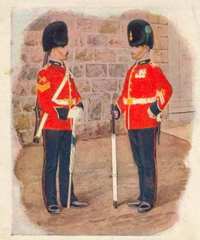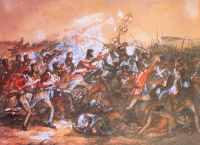Royal Dublin Fusiliers

Royal Dublin Fusiliers — an Irish infantry regiment in the British Army.
There were two regular battalions: the 1st (nicknamed the "Blue Caps"), and the 2nd (nicknamed the "Old Toughs"). Its catchment area was Dublin and the surrounding counties.
The regiment, along with many other Irish regiments, was disbanded in 1922, following the Anglo-Irish Treaty.

History — the 1st battalion dates to 1748, when it was raised in India as the "Madras European Regiment" in the service of the Honourable East India Company (i.e. it was not a regular British Army regiment). The 2nd Battalion, similarly, was raised in Bombay as the "Bombay Fusiliers". Most of the Battle Honours of the RDF ("Arcot", "Condore", "Wandiwash", etc.) were awarded during this East India Company period when the regiments were maintained as private or mercenary formations.

Following the Indian Mutiny of 1857, both regiments were subsumed into the regular British Army as respectively the 102nd Foot and 103rd Foot of the Line. Under the Childers reforms of 1881 the British army was reorganized into territorial units – thus the 102nd and 103rd were amalgamated to form the Royal Dublin Fusiliers, 1st and 2nd Battalions.
Even before this, recruitment was disproportionately of Irishmen. An old saying goes of the British Empire, "The English enjoyed it, the Scotch administered it, and the Irish fought for it." Until the "New Armies" were raised in the First World War, the officer class was predominantly English, and when Irish exclusively Protestant and Unionist.

These later Irish regiments (RDF, Royal Munster Fusiliers, Leinster Regiment, etc) coming so late into the line tended to be "looked down on" by the smarter British outfits. They were thought of as "mercenaries" due to their history of service with the East India Company. And, along with all non-English regiments, were deprecated as "tribals". But some Irish regiments were greatly respected: the Connaught Rangers (88th in the Line) and Royal Inniskilling Fusiliers (27th) in particular.

Boer War — on the outbreak of war, 1899, the 2nd Battalion RDF was already stationed in South Africa, in Natal province: it saw immediate action in Talana Hill. Both battalions were involved in some of the fiercest fighting of the war: Colenso, Tugela Heights, Laing's Nek.
 At the Relief of Ladysmith, for their gallantry, the 2nd Dubs were awarded the signal honour of marching into the town at the head of the relieving force.
At the Relief of Ladysmith, for their gallantry, the 2nd Dubs were awarded the signal honour of marching into the town at the head of the relieving force.In all, the Dublin Fusiliers lost close to 700 men (the strength of a battalion) in the Boer War. Of the 2nd Dubs, only one officer survived unwounded. In 1907, a memorial arch was erected in St. Stephen's Green, Dublin, to honour these fallen. It was customarily known as "Traitor's Gate".

World War 1 — 11 battalions served in the course of the war. The 2nd Battalion was part of the British Expeditionary Force sent to France in August 1914. The 1st Battalion, stationed in India at the outbreak of war, took part in the first Gallipoli landings, 1915.
The 1st, 6th and 7th were involved in the Gallipoli Campaign, the 1st being virtually annihilated. The 6th and 7th subsequently fought in Salonika, a malaria-ridden front which Kaiser Wilhelm was pleased to describe as "the biggest internment camp in Europe". They later campaigned in Egypt and Jerusalem.
On the Western Front, the 2nd suffered heavily in the Second Battle of Ypres, 1915. In 1916 the 2nd, with a reconstituted 1st, were at the opening of the Battle of the Somme. The 8th, 9th and 10th fought at the Somme later in 1916. The 1st, 2nd, 8th, 9th and 10th were all involved in the 3rd Battle of Ypres, better known as Passchendaele.
By the end of the Great War, 4,777 Royal Dublin Fusiliers had been killed.Easter Rising, 1916 — elements of the 4th, 5th and 10th RDF were engaged in fighting the rebels in Dublin. Max Caulfield, "The Easter Rebellion", 1963, records an incident during the Fusiliers' advance on Rebel positions near Dublin Castle which encapsulates the divided loyalties of the time:

Disbandment— the Irish regiments played little part in the Anglo-Irish War of 1919–1921. Indeed, one Irish regiment – the Connaught Rangers, stationed at the time in India – staged a mutiny in protest against British atrocities at home. After the Anglo-Irish Treaty of 1922, and the establishment of the Irish Free State, most of the Irish regiments – including the Royal Dublin Fusiliers – were disbanded. In the presence of the King, their Colours were laid up in Windsor Castle; the men were given train tickets to Fishguard in Wales, and sailing tickets to Ireland. Many joined the newly-formed Free State Army and formed the backbone of that force that defeated the anti-Treaty IRA in the Irish Civil War.

In intimate company former Fusiliers might acknowledge their regimental past; but in nationalist Ireland it was impolitic to commemorate publicly a connection with the British state. Although 200,000 Irishmen had fought in the Great War, and above 30,000 had died, the war itself was largely forgotten, or remembered merely as a backdrop to the far greater events of Easter 1916. Old soldiers might never die, but in Ireland they kept very very quiet.
In 1948 a Memorial Park was opened in an out-of-the-way part of Dublin. In 2006 the Irish Government held its first official commemoration there.

On the Colours — The Royal Tiger, superscribed "Plassey", "Buxar", with the motto "Spectamur Agendo" underneath. The Elephant, superscribed "Carnatic", "Mysore". At centre, the grenade bearing the Arms of the City of Dublin set in a wreath of Shamrocks.
Battle Honours — the precursor regiments of the Royal Dublin Fusiliers had been mainstays of mercenary and colonial rule in India. Unsurprisingly, the battle honours form an index to Indian military history under British control:
After the Boer War were added "Relief of Ladysmith", "South Africa, 1899–1902". WW1 Honours are a catalogue of the major events in the war …

Full Dress — scarlet tunic with blue facings, racoon-skin hat; the grenade, crowned, is worn on the button, and on the collar with the tiger and elephant; the grenade on the head dress plate bears, in addition, the arms of Dublin and the regimental motto "Spectamur agendo". The shamrock appears surrounding the arms, and also with the harp, on the waist belt.
Motto — Spectamur agendo (We are judged by our deeds).Links
Wikipedia: Royal Dublin FusiliersRDF Association at Great War.ie
Royal Dublin Fusiliers.com
Dublin-Fusiliers.com
RDF at Anglo Boer War.com
RDF in John Stirling, Our Regiments in South Africa, 1903, at Internet Archive.
Michael MacDonagh, The Irish at the Front, 1916, at Internet Archive.